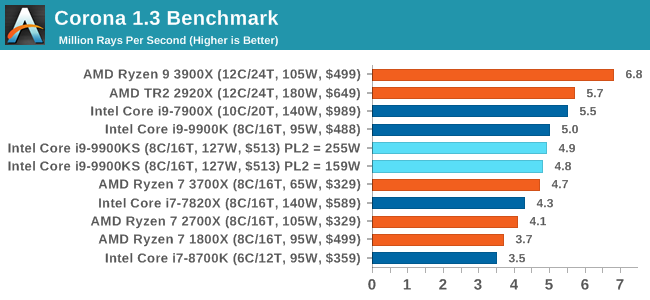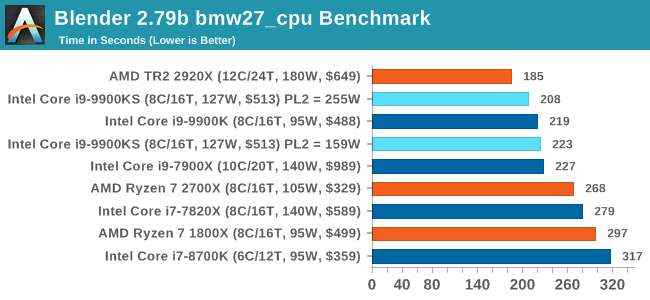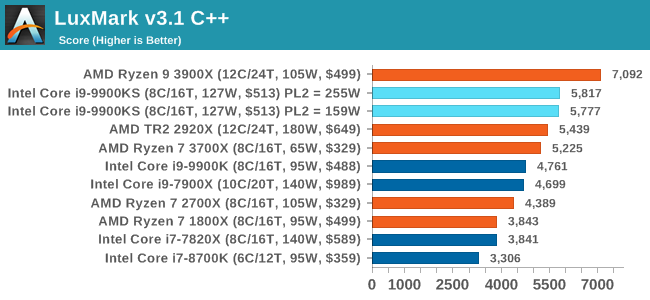The Intel Core i9-9900KS Review: The 5 GHz Consumer Special
by Dr. Ian Cutress on October 31, 2019 10:45 AM ESTCPU Performance: Rendering Tests
Rendering is often a key target for processor workloads, lending itself to a professional environment. It comes in different formats as well, from 3D rendering through rasterization, such as games, or by ray tracing, and invokes the ability of the software to manage meshes, textures, collisions, aliasing, physics (in animations), and discarding unnecessary work. Most renderers offer CPU code paths, while a few use GPUs and select environments use FPGAs or dedicated ASICs. For big studios however, CPUs are still the hardware of choice.
All of our benchmark results can also be found in our benchmark engine, Bench.
Corona 1.3: Performance Render
An advanced performance based renderer for software such as 3ds Max and Cinema 4D, the Corona benchmark renders a generated scene as a standard under its 1.3 software version. Normally the GUI implementation of the benchmark shows the scene being built, and allows the user to upload the result as a ‘time to complete’.
We got in contact with the developer who gave us a command line version of the benchmark that does a direct output of results. Rather than reporting time, we report the average number of rays per second across six runs, as the performance scaling of a result per unit time is typically visually easier to understand.
The Corona benchmark website can be found at https://corona-renderer.com/benchmark

Interestingly both 9900KS settings performed slightly worse than the 9900K here, which you wouldn't expect given the all-core turbo being higher. It would appear that there is something else the bottleneck in this test.
Blender 2.79b: 3D Creation Suite
A high profile rendering tool, Blender is open-source allowing for massive amounts of configurability, and is used by a number of high-profile animation studios worldwide. The organization recently released a Blender benchmark package, a couple of weeks after we had narrowed our Blender test for our new suite, however their test can take over an hour. For our results, we run one of the sub-tests in that suite through the command line - a standard ‘bmw27’ scene in CPU only mode, and measure the time to complete the render.
Blender can be downloaded at https://www.blender.org/download/

All the 9900 parts and settings perform roughly the same with one another, however the PL2 255W setting on the 9900KS does allow it to get a small ~5% advantage over the standard 9900K.
LuxMark v3.1: LuxRender via Different Code Paths
As stated at the top, there are many different ways to process rendering data: CPU, GPU, Accelerator, and others. On top of that, there are many frameworks and APIs in which to program, depending on how the software will be used. LuxMark, a benchmark developed using the LuxRender engine, offers several different scenes and APIs.
In our test, we run the simple ‘Ball’ scene on both the C++ and OpenCL code paths, but in CPU mode. This scene starts with a rough render and slowly improves the quality over two minutes, giving a final result in what is essentially an average ‘kilorays per second’.

Both 9900KS settings perform equally well here, and a sizeable jump over the standard 9900K.
POV-Ray 3.7.1: Ray Tracing
The Persistence of Vision ray tracing engine is another well-known benchmarking tool, which was in a state of relative hibernation until AMD released its Zen processors, to which suddenly both Intel and AMD were submitting code to the main branch of the open source project. For our test, we use the built-in benchmark for all-cores, called from the command line.
POV-Ray can be downloaded from http://www.povray.org/

One of the biggest differences between the two power settings is in POV-Ray, with a marked frequency difference. In fact, the 159W setting on the 9900KS puts it below our standard settings for the 9900K, which likely had an big default turbo budget on the board it was on at the time.











235 Comments
View All Comments
Jorgp2 - Thursday, October 31, 2019 - link
9900KS most likely does it at a lower voltage and power, plus it has hardware mitigations.Korguz - Thursday, October 31, 2019 - link
this right there... shows you didnt read this article.edzieba - Friday, November 1, 2019 - link
The 9900KS has a different hardware mitigation report to the 9900K. See Phor0nics article p.1: https://www.phoronix.com/scan.php?page=article&...Khenglish - Thursday, October 31, 2019 - link
I think it would be interesting to see how the 3700x and 3800x do if you bump their power limit up to 9900KS levels. The 3700x is probably being held back quite a bit at 65W but still is competitive.imaheadcase - Thursday, October 31, 2019 - link
"AMD also has the 16-core Ryzen 9 3950X coming around the corner, promising slightly more performance than the 3900X, and aside from the $749 MSRP, it’s going to be an unknown on availability until it gets released in November."Wasn't that delayed till December? I swear i saw that in the news..
imaheadcase - Thursday, October 31, 2019 - link
oh nm i got months messed up. I read that last month..forgot its already Oct. LOLjgarcows - Thursday, October 31, 2019 - link
Your IGP tests aren't very useful. I'm not going to run a game at 720p with the lowest settings on my IGP if I'm getting 250+ FPS. I'm going to increase the resolution or graphics settings until I'm getting the best visuals I can while still hitting 60 FPS.Please compare with settings that give around 60 FPS on the IGPs so we can get an idea of how the integrated graphics performs when you actually stress it some. At 720p, you are just testing the CPU cores and not the IGP at all.
Slash3 - Thursday, October 31, 2019 - link
This has been a bugaboo of mine for quite a while.There are *no* IGP benchmarks. What you're seeing is a benchmark detail setting that AT refers to as "IGP." In effect, "Very Low" detail. The test is still run on the GeForce GTX 1080 and not the CPU's built-in graphics.
My other complaint is that the use of a GTX 1080 makes the High preset results entirely meaningless, as they're almost always limited by the GPU. It's a waste of graphs and a waste of test time.
katsetus - Friday, November 1, 2019 - link
The gaming benchmarks as they are shown here are absolutely pointless - all they show is that the GPU is the more important factor.Them saying that they keep the GTX 1080 for the comparability with older results is pointless, when the variability between three generations of CPUs is 3% at best, because the whole thing is nowhere near being limited by the CPU.
Cellar Door - Thursday, October 31, 2019 - link
Blender chart is missing Ryzen 3700 and 3900.